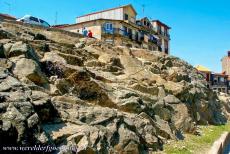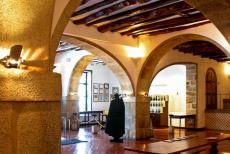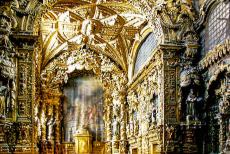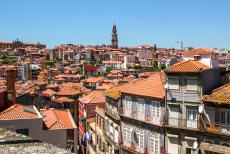Historic Centre of Porto and the Luis I Bridge: The city of Porto was founded during the Roman period. Porto is located along the estuary of the Douro River. The historic centre of Porto lies on a steep, rocky hill. Prince Henry the Navigator of Portugal was born in Porto, he supported the maritime discoveries of Portugal and made it a great seafaring power in the 15th century. His body rests in the Founder's Chapel of the Monastery of Batalha. The history of Porto can be seen in the numerous monuments from the past, such as the bell tower Torre dos Clérigos, once the tallest building in Portugal. Many buildings in the historic centre of Porto are adorned with azulejos (Porteguese ceramic tiles). The most notable is the São Bento Railway Station, the building is decorated with twenty thousand azulejos, the tile panels of São Bento depict historic scenes. The 15th century Santa Clara is a church in Manueline style. The 12th century Porto Cathedral is one of the oldest monuments of the city. Porto is well known for the production of port wine. The wine grapes are grown in the vineyards of the Alto Douro. There are numerous wine cellars in Vila Nova de Gaia, a suburb of Porto. Several cellars are open to the public, it is possible to taste and purchase the port wine. The city of Porto used to play a major role in the wine trade between Great Britain and Portugal. The Historic Centre of Porto, the Luis I Bridge and Monastery of Serra do Pilar gained the status as a UNESCO World Heritage in 1996.
www.werelderfgoedfotos.nl © Copyright World Heritage Photos classic car road trip

A traditional Rabelo boat on the Douro, the River of Gold, in the historic centre of Porto. The wooden Rabelo boats were used to transport the port wine from the Alto Douro wine region to Porto. Porto is situated along the estuary of the Rio Douro in Portugal. The most famous export product of Portugal is the port wine, the wine takes its name from the city of Porto. The Historic Centre of Porto gained the status as a UNESCO World Heritage in 1996.

A traditional Rabelo boat on the Douro, the River of Gold, in the historic centre of Porto. The wooden Rabelo boats were used to transport the port wine from the Alto Douro wine region to Porto. Porto is situated along the estuary of the Rio Douro in Portugal. The most famous export product of Portugal is the port wine, the wine takes its name from the city of Porto. The Historic Centre of Porto gained the status as a UNESCO World Heritage in 1996.

Historic Centre of Porto: The construction of the Dom Luis I Bridge started in 1881, the bridge was opened in 1886. The bridge is the most famous bridge of Porto and is an icon of the city, it spans the river Douro between Porto and Vila Nova de Gaia. The steel Dom Luis I Bridge has an upper and lower deck, the upper deck is used for pedestrians and the metro, the lower deck is used for road traffic and pedestrians. The bridge was designed by an admirer of Gustave Eiffel.

Historic Centre of Porto: The city of Porto is situated on a steep, rocky hill, that is why Porto has an upper part and a lower part. Porto was founded during the Roman period. Porto is situated along the estuary of the river Douro. Prince Henry the Navigator of Portugal was born in Porto, he supported the maritime discoveries of Portugal and made it an important seafaring power in the 15th century. Now, Porto is well known for its port houses and the historic Ribeira Quarter.

Historic Centre of Porto: A port wine lodge situated in Vila Nova de Gaia. Vila Nova de Gaia is situated on the south bank of the river Douro and connected to the historic centre of Porto by the Dom Luis I Bridge. Porto played an important role in the wine trade between Great Britain and Portugal. Most of the wine caves are situated in Vila Nova de Gaia, the wine district offers some of the best views over the historic centre of Porto.

Historic Centre of Porto: A wine tasting room in Vila Nova de Gaia. The city of Porto is famous for the production of port wine. There are numerous wine cellars in Vila Nova de Gaia, a suburb of Porto. Merchants from England were allowed to establish their port wine lodges in the city of Porto, this explains the English names for the port wine houses. The correct name for the city is Porto, Oporto is the English name.

Historic Centre of Porto: Numerous port barrels in one of the wine cellars. Porto is famous for the production of port wine. There are numerous wine cellars in Vila Nova de Gaia. The grapes for the famous port wine are the main product of the Alto Douro. The Alto Douro wine region is situated along the banks of the Douro River. The Historic Centre of Porto was inscribed on the UNESCO World Heritage List in 1996.

Historic Centre of Porto: The decorated façade of the Saint Anthony Church of the Gatherers. The church is dedicated to the Saint Anthony of Padua, a Portuguese born saint. The Baroque church was built in the late part of 17th century. The azulejos, the Portuguese tiles, depict the story of Saint Anthony and the Assumption of the Blessed Virgin Mary. The church is situated nearby the São Bento Railway Station.

Historic Centre of Porto: The São Bento Railway Station is decorated with more than twenty thousand azulejos, Portuguese ceramic tiles. The azulejo panels depict historic scenes. The São Bento Railway Station was built on the site of a monastery, named São Bento. The construction started in 1900 and was completed in 1916. Numerous buildings in the historic centre of Porto are adorned with colourful azulejos, the most famous is the São Bento Railway Station.

Historic Centre of Porto: The São Bento Railway Station is decorated with azulejos, the famous Portuguese ceramic tiles. The tile panels represent several scenes from the history of Portugal, such as the Conquest of Ceuta and the Battle of Valdevez, the history of the city of Porto and the port wine. The blue and white azulejos tiles were placed over a period of eleven years. The São Bento Railway Station is still in use.

The palace of the counts of Azevedo was built in the historic centre of Porto in the 17th and 18th centuries, the palace is situated close to the Sé do Porto, Porto Cathedral. Nowadays, the palace houses several apartments. The history of Porto can be seen in the numerous monuments from the past. The Historic Centre of Porto, the Dom Luis I Bridge and the Monastery of Serra do Pilar gained the status as a UNESCO World Heritage in 1996.

Historic Centre of Porto: The Santa Clara Church was built in Manueline style. The 15th century Santa Clara has a plain façade, but the interior of the church is gold plated and one of the most exceptional examples of wood carving in Portugal. The wood carvings of the Santa Clara were gilded in the 17th century. In Portugal, gilded wood carving was extremely popular during the 17th century.

Historic Centre of Porto: The gold plated interior of the Santa Clara Church. The small church is considered a masterpiece of the Baroque and Rococo. The church has a Gothic and Renaissance baptismal font. The gilded wood carvings depict numerous angels and saints. The Santa Clara is situated in the historic centre of Porto nearby Porto Cathedral, the Sé do Porto, the 12th century Porto Cathedral is one of the oldest monuments of the city.

Historic Centre of Porto: One of the narrow streets of the Ribeira Quarter. The Ribeira Quarter is situated in the lower part of the historic centre of Porto, the Ribeira Quarter is a network of medieval cobbled streets, situated along the river Douro and nearby the Dom Luis I Bridge. The Ribeira Quarter is one of the most visited places in Porto. During the Age of Discovery, ships set sail from the ancient harbour at Ribeira.

Historic Centre of Porto: The traditional barcos rabelos on the Douro River. The wooden barcos rabelos boats transported the port wine from the Alto Douro Wine Region to the historic centre of Porto, nowadays, road tanker trucks are used to transport the wine. The Alto Douro is also an UNESCO World Heritage. Please visit the World Heritage Photos of the Alto Douro Wine Region on this website. The historic centre of Porto was added the UNESCO World Heritage List in 1996.

The Dom Luis I bridge viewed from the historic centre of Porto. The steel bridge spans the river Douro between the historic centre of Porto and Vila Nova de Gaia. The former Monastery of Serra do Pilar is located in Vila Nova de Gaia, on the opposite site of the Douro, the monastery is located high above the Douro and is a landmark of Vila Nova de Gaia, the monastery was built in the 16th century.

Historic Centre of Porto: Porto and the Torre dos Clérigos, the tower of the Clergy, viewed from the Terreiro da Sé, the Cathedral Square. The Torre dos Clérigos is the tower of the Igreja dos Clérigos, the Church of the Clergy. The towers rises high above the historic centre of Porto, the Torre dos Clérigos was once the tallest building in Portugal. The Baroque church and its tall bell tower were built between 1754 and 1763. The Torre dos Clérigos is a symbol of the city of Porto.

Historic Centre of Porto: The Pelourinho, Portuguese for pillory, in front of Porto Cathedral, the Sé do Porto. Numerous towns across Portugal has a Pelourinho. In the past, the Pelourinho was used for public punishment of criminals. Pelourinhos were usually erected in the main square of a town, in front of a palace or the main church, the Neo-Baroque Pelourinho of Porto was never used, the granite column was erected in the 1940s when Porto Cathedral was restored.

Historic Centre of Porto: The Gothic cloister of the Sé do Porto, the Porto Cathedral, was built in the 14th century. The cloister walls are adorned with Baroque white and blue azulejos. The tile panels depict several scenes such as the Metamorphosis of Ovidius, the life of the Mother Mary and the Song of King Solomon. The azulejo has become a symbol of Portugal. The iconic glazed ceramic tiles can be seen everywhere, on the façades of churches, fountains and houses.

Historic Centre of Porto: The coffered ceiling of the Chapter House of the Porto Cathedral was painted by the Italian artist Giovanni Battista Pachini in 1737. The panels represent allegories of moral values, in the centre is Saint Michael, on either side Authority and Liberty, surrounded by twelve figures, representing the moral values, among them Wisdom, Prudence, Justice, Charity, Truth, Divinity, Mercy and Secrecy. The Chapter House is also home to a collection of sacred art.
